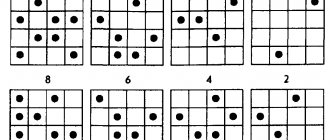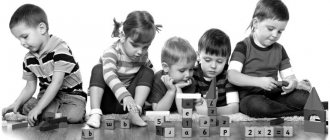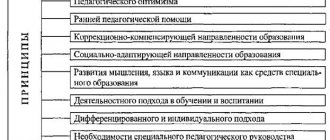As a rule, mental retardation is detected in preschool and primary school age, when the child is faced with the need to remember a lot of information, build logical chains and concentrate on one activity.
This is mainly caused by the slow maturation of the central nervous system, therefore, with timely correction, children with mental retardation catch up with their peers and can study in a regular school. The correction process is complex, subtle and lengthy. Its basis is a trusting relationship with the child and taking into account his individual characteristics. Parents must understand well how their baby feels, thinks, lives, in order to provide him with the necessary help, correctly build a daily routine, study, etc.
Higher mental functions and speech
Memory
Children with mental retardation do not remember information well because their short- and long-term memory capacity is limited and there are mechanical memory impairments. Their memories are fragmentary, incomplete, a lesson just learned is quickly forgotten. Poor memory interferes during class: for example, such a child has to constantly be reminded of the conditions of a task or a rule, he confuses words, etc.
It takes them more tries to remember something, so they need to repeat new information over and over again. When reproducing it, a child with mental retardation also needs more time, since it takes him a long time to find the right words.
Psychologists and neurologists recommend teaching your child various memorization techniques to develop memory and thinking.
Perception
Due to poor memory about many objects, concepts, and phenomena, children with mental retardation develop a fragmented idea: the overall picture is there, but some pieces of the mosaic are missing.
It has been proven that visual material is absorbed much better than verbal material, so when explaining it is necessary to use drawings, simple diagrams, and infographics.
Attention
With mental retardation, it is difficult for a child to maintain attention on one object or activity for a long time; he is constantly distracted by something. Teachers often scold him for restlessness and chatter in class, and his inability to complete the task to the end.
To make activities at school and at home more effective and interesting for the child, it is necessary to organize them so that there is a frequent change of activities. In the room where the child learns lessons there should be no external stimuli - computer, radio, TV.
Thinking
The imaginative thinking of such children is impaired, that is, they cannot imagine in detail a specific situation or object in their minds, which is necessary, for example, in mathematics lessons. Abstract thinking (an abstract search for a solution to a problem, the ability to look at the situation as a whole, without resorting to experience or the senses) and logical thinking (the ability to build cause-and-effect relationships, applying and analyzing previously acquired knowledge) work only if the child is guided by an adult - teacher, mom.
On his own, a child cannot make any general conclusion, classify information, highlight the main characteristics of objects, compare, find differences and commonalities between them, find connections, etc.
Speech
Delayed mental development is often accompanied by speech disorders such as: dyslalia (inability to correctly pronounce sounds with normally developed speech organs), dysgraphia (difficulties in mastering writing) and dyslexia (difficulties in mastering reading).
Children with mental retardation often begin to speak well late, pronounce many sounds incorrectly, have a small vocabulary, and find it difficult to construct a long sentence. Here the help of a speech therapist-defectologist is needed.
Psychological and pedagogical characteristics of children with mental retardation
Teacher-defectologist A.V. Belogura
Psychological and pedagogical characteristics of children with mental retardation.
The problem of mental retardation and learning difficulties is recognized as one of the most pressing psychological and pedagogical problems by psychologists and teachers around the world.
The children's population currently consists of three large groups: normally developing children, children with developmental disorders of varying degrees, including disabled children.
Of particular concern is the significant increase in the number of children with mental retardation (MDD). They require special learning conditions, which can be provided in special kindergartens, where, along with general tasks, the problems of correcting deficiencies in mental development are also solved.
Psychological and pedagogical characteristics of children with mental retardation.
The problem of mental retardation and learning difficulties is recognized as one of the most pressing psychological and pedagogical problems by psychologists and teachers around the world.
The children's population currently consists of three large groups: normally developing children, children with developmental disorders of varying degrees, including disabled children.
Of particular concern is the significant increase in the number of children with mental retardation (MDD). They require special learning conditions, which can be provided in special kindergartens, where, along with general tasks, the problems of correcting deficiencies in mental development are also solved.
One of the main reasons for the difficulty of teaching and learning in children is a special state of mental development of the individual compared to the norm, which in defectology is called “mental retardation” (RD).
In its most general form, the essence of mental retardation is as follows: the development of thinking, memory, attention, perception, speech, and the emotional and volitional sphere of the personality occurs slowly and lags behind the norm.
Limitations of mental and cognitive capabilities do not allow the child to successfully cope with the tasks and demands that society places on him.
For such a child, play motivation remains the leading one for much longer (often throughout all years of primary school), and educational interests are formed with difficulty and to a minimal extent. Due to the poorly developed voluntary sphere (the ability to concentrate, switch attention, perseverance, the ability to retain knowledge, work according to a model), the child gets tired and exhausted very quickly.
Due to the insufficient ability for his age to compare, generalize, abstract, and classify, the child is not able to independently, without special pedagogical assistance, learn the minimum content of the educational program.
Often, difficulties are aggravated by a weak ability to analyze sound and semantics of speech, as a result of which the child poorly masters reading skills and has difficulty mastering written speech.
Due to the functional immaturity of the nervous system, the processes of inhibition and excitation are poorly balanced. The child is either very excitable, impulsive, aggressive, irritable, constantly conflicts with children, or, conversely, is constrained, inhibited, fearful, as a result of which he is subject to ridicule from children.
Common features of children with mental retardation:
- Low performance of children as a result of increased exhaustion.
- Immaturity of emotions and will.
- The stock of general information and ideas is limited.
- Primitive vocabulary.
- Lack of formation of analysis, synthesis, comparisons and conclusions.
- Incomplete formation of gaming activity.
- Low level of self-control or lack of it.
- Inability to plan your activities.
Etiology
(reasons) for the appearance of ZPR
:
- Heredity;
- Social factors:
- pedagogical neglect as a result of limited emotional contact with the child both in the early stages of development (up to three years) and in later age stages.
- Unfavorable course of pregnancy and childbirth
:
Unfavorable pregnancy
- maternal illnesses during pregnancy (rubella, mumps, influenza);
- chronic diseases of the mother (heart disease, diabetes, thyroid disease);
- toxicosis, especially in the second half of pregnancy;
- toxoplasmosis;
- intoxication of the mother’s body due to the use of alcohol, nicotine, drugs, chemicals and medications, hormones;
- incompatibility of the blood of mother and baby according to the Rh factor.
Pathology of childbirth:
- injuries due to mechanical damage to the fetus.
— asphyxia of newborns and its threat.
Genetic types of mental retardation
.
Clinical and psychological studies conducted by T.A. Vlasova, M.S. Pevzner, K.S. Lebedinskaya et al., made it possible to identify four genesis types of mental development delay: constitutional, somatogenic, psychogenic, cerebral-organic origin.
ZPR of constitutional origin
The state of mental retardation is determined by heredity. Children with this type of mental retardation are characterized by harmonious immaturity of both physique and psyche, which gives grounds to designate such a form of delay as harmonious psychophysical infantilism. In children of this group, there is a significant lag in mental development from their normal age, which manifests itself mainly in the emotional and volitional sphere with relatively preserved (albeit slower than normal) cognitive activity.
ZPR of psychogenic origin
Children in this group have normal physical development and are somatically healthy. According to research, most of these children have brain dysfunction. Their mental infantilism is caused by a socio-psychological factor—unfavorable upbringing conditions. A striking example is children raised in an orphanage. Emotional derivation (deprivation of maternal warmth, emotional richness of relationships), monotony of the social environment and contacts, deprivation, weak individual intellectual stimulation often lead to a slowdown in the rate of mental development of the child; as a result, a decrease in intellectual motivation, superficiality of emotions, lack of independence of behavior, infantilism of attitudes and relationships.
ZPR of somatogenic origin
Children in this group are born to healthy parents. Developmental delay is a consequence of diseases suffered in early childhood that affect the development of brain functions: chronic infections, allergies, dystrophy, dysentery. Long-term, severe, often chronic diseases sharply reduce the mental tone of children. Despite the fact that the primary intellect is not impaired, due to their exhaustion and absent-mindedness, they turn out to be extremely unproductive in the process of schoolwork. Thus, often pronounced brain dysfunction is combined with a decrease in mental infantilism, in which the emotional-volitional sphere is characterized by immaturity with relative preservation of intelligence.
ZPR of cerebral-organic origin
The disruption of the rate of development of intelligence and personality is caused in this case by a more severe and persistent local disruption of the maturation of brain structures.
The causes of various abnormalities in brain development are pathology of pregnancy, including severe toxicosis, viral flu suffered by the mother, malaria, hepatitis, alcoholism and drug addiction of the mother or father; birth pathologies, including prematurity, birth trauma, asphyxia (suffocation of the fetus), severe illnesses in the first year of life (neuroinfection), severe infectious diseases.
The listed characteristics of students are a serious obstacle to their learning. Children with mental retardation need systematic medical, psychological and pedagogical assistance.
With interest on the part of the teacher, an individual approach, and intensification of learning, these children can relatively easily fill in the gaps in their knowledge.
Features of mental processes in children with mental retardation
Features of thinking.
One of the psychological characteristics of children with mental retardation is that they have a delay in the development of all forms of thinking.
Thinking
– a process of human cognitive activity, characterized by a generalized and indirect reflection of reality.
A delay in the development of thinking is one of the main features that distinguishes children with mental retardation from their normally developing peers. It manifests itself in all components of the structure of thinking:
1. In case of a deficiency of the motivational component, manifested in extremely low cognitive activity, avoid intellectual stress up to the point of abandoning the task.
2. Irrationality of the regulatory - whole component, due to the lack of need to set a goal.
3. In the long-term unformation of the operational component, i.e. mental operations of analysis, synthesis, generalization, comparison.
4. Violation of the dynamic aspects of thought processes.
Children with mental retardation develop uneven types of thinking. The most pronounced lag is in verbal-logical thinking (operating with ideas, sensory images of objects), visual-effective thinking (associated with the real physical transformation of an object) is closer to the level of normal development.
Features of memory and attention.
Attention is one of the important prerequisites for all types of conscious activity, primarily cognitive.
There are involuntary (non-targeted) and voluntary (targeted) attention. The working level of attention is determined by a set of its main characteristics: volume, concentration, switchability.
Attention span
- this is its information capacity, i.e. the number of objects simultaneously clearly perceived during perception. The average normative amount of attention during simultaneous perception does not exceed five to seven unrelated objects. When perceiving something related to objects (letters in a word, details of a design), the volume of objects covered by attention increases significantly.
Concentration and attention span
- this is the ability not to deviate from the goal, from directed mental activity, to maintain focus on the object of attention.
Concentration and stability of attention are an important energy base for a student’s mental performance. Switching attention
- the ability to move it from one object to another - underlies the transition from one type of activity to another.
The opposite state of attention is absent-mindedness, which is characterized by instability, distractibility, and lack of concentration.
With mental retardation, an insufficient level of attention is one of the significant and noticeable features of cognitive activity.
Children with mental retardation are extremely distracted in class, often distracted, and are unable to listen with concentration or work for more than 5–10 minutes.
Distraction of attention and a decrease in the level of concentration are observed when children are tired. They stop absorbing educational material, resulting in significant gaps in knowledge.
Their own powerlessness, the inability to concentrate on a task causes irritation in some, and in others - a categorical refusal to work.
Most children with mental retardation are characterized by weakened attention to verbal (verbal) information. Even during an interesting story, such children begin to yawn and get distracted by other things. These features are especially pronounced when there are distractions in the environment.
Memory -
a mental process that organizes, stores, and reuses past experiences.
Memory deficiencies significantly slow down and reduce the productivity of cognitive activity.
In children with mental retardation, their memory is significantly weakened, they are prone to thoughtless mechanical learning of material, but this method of mnemonic activity is difficult for them, since the memory mechanisms themselves are weakened.
They are characterized by sharp fluctuations in reproduction productivity, and they quickly forget what they have learned.
Children with mental retardation problems reproduce verbal material much worse, spend significantly more time on recall, while independently making almost no attempts to achieve more complete recall, and rarely use auxiliary techniques for this.
In children with mental retardation, the self-organization of mnemonic activity noticeably suffers. They do not know how to use rational memorization techniques; they cannot and do not strive to control their actions and memorization results.
Features of speech.
Speech -
the leading form of communication and thinking mediated by language. Readiness for schooling includes a certain level of speech development: correct sound pronunciation, the ability to distinguish and differentiate acoustic characteristics of sounds, sufficient for full communication with others, the level of vocabulary and grammatical structure, the ability to logically and coherently construct statements, speech activity.
The speech of children with mental retardation has a number of features, which include: a low level of orientation in the sound activity of speech; insufficient pronunciation of whistling, hissing sounds and the sound “r”, due to sluggishness of articulation, leading to their unclear sound.
The vocabulary of children in this category is dominated by words with specific, well-known meanings. They mainly use categories such as noun and verb. Of the adjectives, they mainly use qualitative ones, denoting characteristics.
In children's speech, pronouns and adverbs are not sufficiently represented. Such children slowly incorporate into their speech new words and concepts acquired during the learning process.
Children have difficulty learning the rules for marking sentence boundaries.
The peculiarities of speech development of this category of students may manifest themselves unevenly: in some, phonetic-phonemic disorders predominate (violation of sound pronunciation combined with defects in sound discrimination), in others - lexical-grammatical disorders.
Features of motor skills.
Motor skills are among the highest mental functions. In children with mental retardation, deviations in the development of the motor sphere are observed: violation of voluntary regulation of movements, insufficient coordination and clarity of involuntary movements, difficulty in switching and automation.
The motor skills of the hands and fingers suffer most in these children. Deviations in the development of the motor sphere in children with mental retardation create certain difficulties in educational activities. They have a particularly adverse effect on mastering the skills of writing, drawing, and manual labor.
Learning motivation.
Formed motivation is one of the main driving forces of a child’s learning.
The educational motivation of children with mental retardation is sharply reduced. For a long time, the leading activity for them continues to be the yoke in its elementary form: children avoid complex games of a plot-role nature with rules and prohibitions that are close to educational ones.
Intellectual retardation greatly inhibits the development of cognitive interest. In order to avoid an overwhelming and unpleasant learning situation for them and intellectual stress, children with mental retardation development resort to refusing assignments and attending school as a defense.
Emotional sphere.
The emotional sphere plays a huge role in a person’s life. It helps internal regulation of behavior.
In children with mental retardation, emotional development is delayed: they constantly experience difficulties with the environment of adaptation, which disrupts their emotional comfort and mental balance. More than other children, they need stress relief, pedagogical assistance, and special expansion and enrichment of sensory space.
Features of behavior.
Behavior in the broad sense of the word is a system of interrelated reactions carried out by living organisms to adapt to the environment.
Deviations in an individual’s behavior negatively affect the development of the individual himself.
There are several groups of children with mental retardation depending on their mental characteristics and behavior - balanced, inhibited and excitable.
Due to the fact that most children with mental retardation have deficiencies in the development of the nervous system, affective outbursts often end in headache, fever, and fatigue.
An overview of the developmental features of children with mental retardation shows that the phenomenon of delay is heterogeneous both in pathogenesis and in the structure of the defect.
At the same time, children in this category are characterized by typical developmental tendencies that distinguish them from the norm: immaturity of the emotional-volitional sphere, disaptive forms of social behavior, a reduced level of cognitive activity, and, therefore, their readiness to assimilate knowledge and subject concepts is not sufficiently formed.
Serious limitations in social, personal and educational opportunities determine the need to classify these children as students with “special needs” who require special correctional and pedagogical support.
Literature.
1. N.N Avdeeva, M.G. Elagina, S.Yu. Meshcheryakova. Psychological foundations of personality formation. – M., 1986.
2. L. N. Blinova. Diagnosis and correction in the education of children with mental retardation: Textbook. – M.: Publishing house – NTsENAS, 2003.
3. T. A. Vlasova, V. I. Lubovsky, N. A. Tsypina. Children with mental retardation. – M., 1984.
4. L.S. Vygodsky Fundamentals of defectology // Collection. cit.: In 6 vols. – M., 1983.
5. A.R. Luria. Attention and memory. – M., 1990.
6. A. K. Markova, T. A. Matis, A. B. Orlov. Formation of learning motivation. – M., 1990.
7. S. Ya. Rubinstein. Psychology of mentally retarded schoolchildren. – M., 1979.
8. I. V. Strakhov. Cultivating attention. – M., 1970.
9. U. V. Ulienkova. Children with mental retardation. – N – Novgorod, 1994.
10. S. G. Shevchenko. Correctional and developmental training: Organizational and pedagogical aspects: Method. A manual for teachers of classes of correctional and developmental education. – M.: Humanite. Ed. VLALOS Center, 1999.
11. S. G. Shevchenko. Teaching children with mental retardation: A manual for teachers. – Smolensk, 1994.
Emotional-volitional sphere
Mental retardation especially strongly affects a child’s ability to control his actions, feelings, energy, and will. He is literally in captivity of his own weak emotional-volitional sphere:
- constant sudden mood swings;
- suggestibility, quickly falls under the influence of others;
- frequent manifestations of aggression, outbursts of anger;
- increased anxiety, fear;
- low self-esteem, lack of self-confidence;
- not wanting to do anything;
- inability to act independently;
- hyperactivity;
- often commits actions while in a state of strong excitement, in a state of passion.
Due to the fact that a child with mental retardation speaks poorly, has difficulty distinguishing emotions, he cannot express his own experiences, for example, in time to say that he is tired or upset, he is bored. He is also unable to identify emotions in other people.
A child with mental retardation often looks for a “mentor”, an authoritative peer or an adult to whom he is strongly attached and whom he strives to imitate in everything.
At the same time, mental retardation prevents the child from building normal relationships with peers. He is reluctant to make contact, he is afraid of the team, so he is not accepted into games and events. A child with mental retardation has a greater chance of making friends among younger children, but mostly he will seek solitude. Here the exception is children in whom mental retardation has a constitutional etiology; on the contrary, they are very sociable.
Causes
There are biological and social reasons for the development of mental retardation.
Biological:
- pregnancy pathologies: severe toxicosis, intoxication, infections, injuries;
- prematurity;
- intrauterine fetal hypoxia;
- asphyxia during childbirth;
- infectious, toxic, traumatic diseases at an early age;
- genetic predisposition;
- trauma during childbirth;
- lagging behind peers in physical development;
- somatic diseases (disturbances in the functioning of various organs);
- damage to certain areas of the central nervous system.
Social:
- restriction of life activity for a long time;
- mental trauma;
- unfavorable living conditions;
- pedagogical neglect.
Depending on the factors that ultimately led to mental retardation, several types of disease are distinguished, on the basis of which a number of classifications have been compiled.
Prognosis and prevention
The lag in the rate of mental development of a child from age norms can and must be overcome. Children with mental retardation are teachable, and with properly organized correctional work, positive dynamics are observed in their development. With the help of teachers, they are able to acquire knowledge, skills and abilities that their normally developing peers master on their own. After graduating from school, they can continue their education at vocational schools, colleges and even universities.
Prevention of mental retardation in a child involves careful pregnancy planning, avoidance of adverse effects on the fetus, prevention of infectious and somatic diseases in young children, and provision of favorable conditions for upbringing and development. If a child is lagging behind in psychomotor development, an immediate examination by specialists and the organization of corrective work are necessary.
Sign up for a consultation. The center's child psychologist, speech pathologist and speech therapist will determine the individual causes of developmental delay, give recommendations for correction, and also draw up a plan for classes in the center and at home. This system of work will make the correctional route the most effective and will successfully harmonize the baby’s development process.
Psychological classification of mental retardation, according to N.Ya. and N.N. Semago
This classification of mental retardation reflects not the causes, but the structure of the disorder.
In the group of child development disorders, the Semago couple distinguishes two fundamental categories:
- Arrested development;
- Partial (partial) immaturity of higher mental functions (and here there will be three options).
In essence, these will all be variants of the ZPR, but with a different structure. We'll look at the first category. It can be called “true ZPR”, because It is the representatives of this category that are characterized by a slower rate of mental maturation. Here the authors distinguish harmonious infantilism and disharmonious infantilism. As the name implies, harmonic means uniform, and disharmonious means the opposite.
Harmonic infantilism ZPR
As mentioned above, such a child looks 1-1.5 years younger than his age. Intellectual and emotional development corresponds to the age he appears to be. All spheres of the psyche are uniformly delayed, that is, the child matures later due to his constitution (the action of hereditary factors is possible). The emotional and cognitive spheres of the child correspond to the level characteristic of a younger age. A child with harmonious infantilism is more suggestible, naive, his emotions are more vivid and spontaneous, even for a schoolchild play motives in activities predominate. They quickly become fed up with intellectual activity, although they are often tireless in the game. They find it difficult to follow established rules of behavior (for example, at school).
No specific correction is required for this type of DPR. They should be sent to school as late as possible, ideally closer to 8 years of age. It is necessary to create a developmental and preventive environment, that is, to ensure that the child passes all normative levels of development and develops the necessary abilities for school, “mature.” Some children of this type need speech therapy. It is important to follow a daily routine, general strengthening moments, and supervision of a good pediatrician. To develop self-regulation, games with rules are suitable (any kind, it is important that the child learns to act according to the rules and learns to wait his turn). To develop coordination and improve performance, it is good to use motor neurocorrection. The prognosis is favorable. Such a child does not need a defectologist-oligophrenopedagogist.
Disharmonic infantilism (unevenly delayed type)
Such a child often also looks younger than his age. Chronic diseases (for example, allergies, visual impairment, diseases of the digestive and respiratory systems), and somatic weakness are typical. Also, the authors of the classification note that children with disharmonic infantilism often have a violation of interhemispheric interaction (left-handedness, unsettled choice of the dominant hand). At the same time, disharmony manifests itself in the fact that the intellectual sphere is ahead of the emotional-volitional sphere. Such children have weak voluntary self-regulation, they can be capricious, emotionally unstable, unbalanced, easily exhausted, and insufficiently critical of themselves. Self-esteem is often either overestimated or underestimated. Learning ability can be at a high level. Spatial representations as the basis of nonverbal intelligence can also develop ahead of schedule.
Correction for this type of mental retardation should include harmonization of the emotional sphere (art therapy, sand therapy, as well as family psychotherapy with an emphasis on child-parent relationships are well suited here), motor neurocorrection (improving neurodynamics, interhemispheric interaction, performance), development of programming functions and control – frontal lobes (as part of cognitive neurocorrection), observation and treatment by specialized doctors for somatic problems. The prognosis is favorable intellectually, but personally there are risks of developing accentuations, psychopathy, and deviant behavior.
Partial (partial) immaturity of the HMF (higher mental functions)
In the group of insufficient development (ID), according to Semago’s classification, two subgroups are distinguished: delayed development (“true” LD - harmonious and disharmonious infantilism) and partial immaturity of higher mental functions.
With harmonious and disharmonious infantilism, the psyche goes through all stages in the process of development, and functions mature. That is, by the age of 9-11, the child catches up with his peers.
In the case of a partially unformed HMF, the development of events is different. This is not just a tempo delay in the maturation of the psyche. Such a child is characterized by a different structure of the disorder. We can say that some parts of the psyche do not mature to normal levels. It turns out to be a kind of “mosaic” of mature and immature HMFs. Moreover, since all mental functions influence each other, after the age of 8-9 years this type of disorder can be classified as disharmonious (that is, we are talking about a distortion of personal development) or total underdevelopment (mental retardation, if the situation was borderline) .
In this case, the partial immaturity of the HMF is of cerebral-organic origin (that is, there is brain damage).
There are three types in this category:
Partial unformation of the HMF with a predominant unformation of the regulatory component.
Imagine a “classic” child with ADHD. Characteristic:
- Impulsiveness;
- Motor and often speech disinhibition;
- Difficulties of voluntariness in activity (when it’s interesting, it does it easily; and when it’s “necessary”, the volitional component cannot ensure concentration);
- The predominance of gaming interests over cognitive ones;
- With sufficiently strict control on the part of an adult, they are capable of performing cognitive tasks;
- There may be difficulty understanding complex speech patterns.
Correction:
- Neuropsychological correction for the formation of programming functions in activity, self-control, self-regulation;
- Psychological assistance to the child and family according to the situation;
- Observation by a pediatric neurologist and/or psychiatrist.
At the same time, the child is physically developed according to his age.
Prognosis: manifestations remain into adulthood, but in general, with early help, the prognosis is favorable. In the worst case, there are risks of personality disorders, secondary learning problems, deviant and antisocial behavior.
Partial immaturity of the HMF of the predominantly verbal and verbal-logical components.
This group includes the majority of so-called “speech” children who previously had the following diagnoses: “DDG”, “ONR”, “CHD”, “developmental dysphasia”, “alalia”.
This violation is characterized by:
- Low speech activity, specificity of speech;
- Sound pronunciation disorders;
- Difficulties in understanding grammar, logical-grammatical constructions;
- Motor clumsiness, dyspraxia;
- When tested, nonverbal intelligence exceeds verbal intelligence;
- In speech there can be semantic substitutions (means one thing, but says another word);
- Often – difficulties in forming spatio-temporal concepts;
- Anxiety, lack of self-confidence;
- Stuttering, tics, and enuresis may occur;
- There may be difficulties in interhemispheric interaction (left-handedness, unsettled choice of the dominant hand);
- Such children may be somatically weakened - allergies, diseases of the gastrointestinal tract, respiratory.
Correction:
- Speech pathologist-defectologist for a long term (several years, including primary school);
- Neuropsychological correction should include the formation of spatiotemporal concepts and the development of interhemispheric connections;
- If the correction begins late, a defectologist-oligophrenopedagogist (since thinking suffers a second time);
- If necessary, provide psychological assistance to the child and family.
Prognosis: with early and well-structured correction, quite favorable. In the worst case (if recommendations are not followed and activities are started late): the risk of developing emotional disturbances, learning problems, and perpetuating speech pathology. At school there is an increased risk of developing dyslexia and dysgraphia. Such children are often diagnosed with “neurosis-like syndrome” by a neurologist.
Partial immaturity of mixed type HMF.
This is the most difficult option in correctional and diagnostic terms, intermediate between mental retardation and mental retardation. These children are characterized by:
- Severe adaptation problems, low adaptive capabilities;
- Low activity, low performance;
- Against the background of fatigue - manifestations of impulsiveness;
- Insufficient formation of thinking operations;
- Underdevelopment of various forms of perception, including phonemic hearing;
- During the learning process, transfer to similar material is difficult;
- Difficulty concentrating and poor memory;
- Low self-esteem, increased level of anxiety;
- There may be protest forms of behavior;
- Lack of formation of spatial representations;
- Difficulties in understanding complex speech structures.
Correction:
- Increasing the level of general activity and tone (including exercise therapy);
- Classes with a defectologist-oligophrenopedagogue;
- Correctional school;
- Classes on the formation of the regulatory component of the psyche and spatial representations (neuropsychologist);
- If necessary, help from a psychologist to the child and family.
Prognosis: depending on the quality of correction, the social and family environment is very different.







